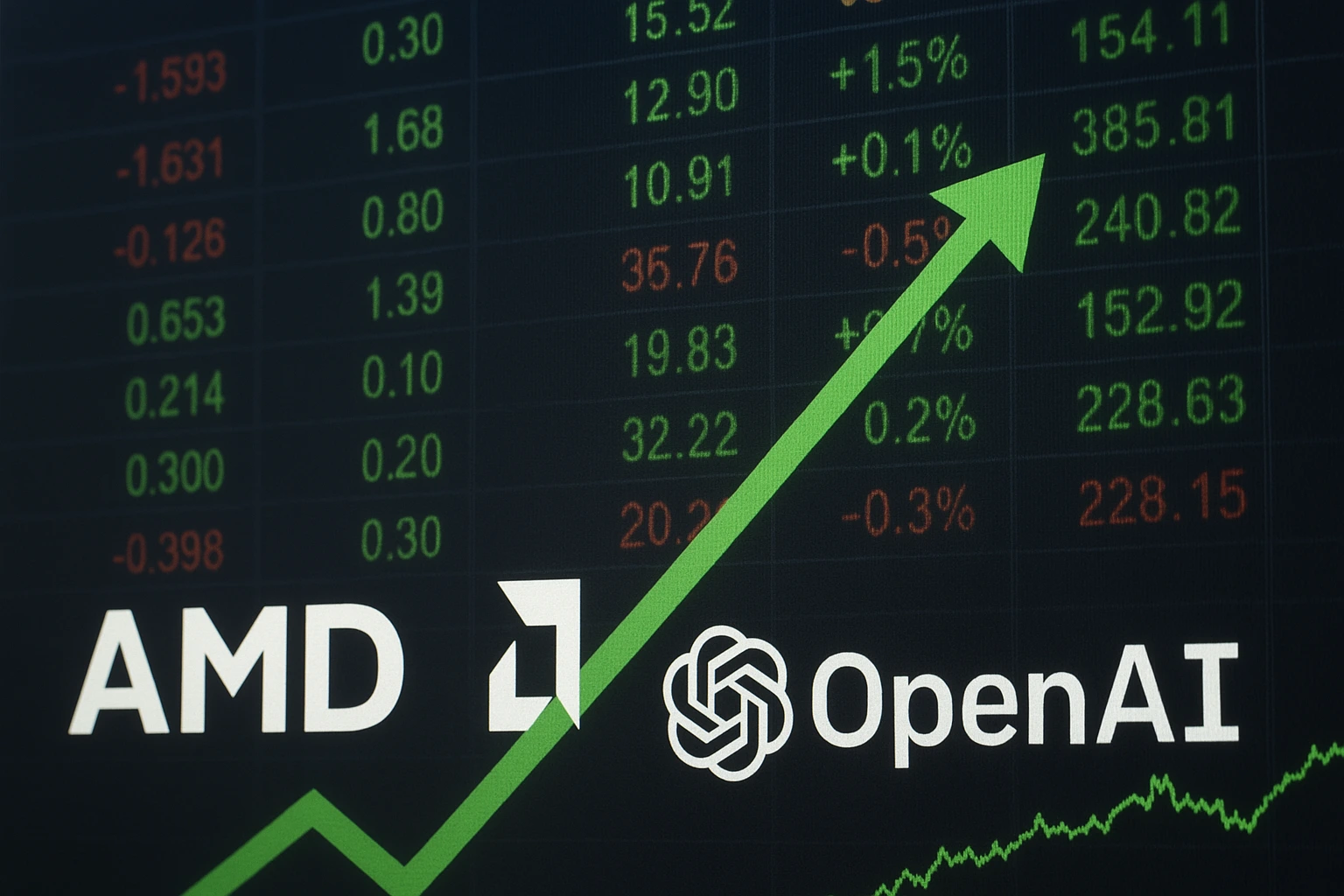SAN FRANCISCO — Shares of Advanced Micro Devices (AMD) surged more than 25% in premarket trading Monday after OpenAI announced plans to acquire up to a 10% stake in the semiconductor company as part of a sweeping partnership to deploy AMD’s high performance Instinct GPUs for artificial intelligence infrastructure.
The agreement one of the largest GPU deployment deals ever in the AI sector underscores OpenAI’s aggressive expansion into AI hardware and infrastructure, while positioning AMD as a core strategic partner alongside industry giants like Nvidia and Oracle.
“This partnership will accelerate our mission to bring the benefits of advanced AI to everyone faster,” OpenAI CEO Sam Altman said in a statement Monday.
Under the terms of the agreement, OpenAI will deploy six gigawatts of AMD’s Instinct graphics processing units over multiple years and hardware generations, beginning with a one gigawatt rollout in the second half of 2026.
In return, AMD has issued a warrant allowing OpenAI to acquire up to 160 million shares of AMD common stock, with vesting tied to deployment milestones and share price performance.
If OpenAI exercises the full warrant, the company could hold roughly 10% ownership in AMD based on current outstanding shares. The deal is valued in the billions of dollars, though specific terms were not disclosed.
The move comes just two weeks after OpenAI unveiled a $100 billion equity-and-supply agreement with Nvidia, which included 10 gigawatts of dedicated compute capacity for OpenAI’s next-generation models.
Together, the Nvidia and AMD agreements account for a significant portion of OpenAI’s 23-gigawatt AI infrastructure roadmap.
Shares of Nvidia fell 1% Monday following the news, as analysts speculated on potential market share shifts in the AI accelerator market.
Industry analysts view the OpenAI-AMD partnership as a significant milestone for AMD, which has long trailed Nvidia in the AI chip market.
“This is a validation moment for AMD’s Instinct product line,” said Daniel Harper, senior semiconductor analyst at TechEdge Research.
By securing OpenAI arguably the most influential AI customer in the world AMD gains credibility and demand visibility it has never had before.
Experts also see the partnership as a strategic hedge for OpenAI amid growing supply chain pressures.
“Relying solely on Nvidia was becoming increasingly risky,” said Carla Jenkins, a supply chain strategist at Silicon Valley Insights. “Diversifying across AMD and potentially Broadcom gives OpenAI more leverage and resilience in scaling its AI compute.”
The deal also reflects the evolving “circular economy” within the AI sector, where capital, equity, and compute flow among the same handful of companies.
Nvidia is investing capital to fund OpenAI’s compute buildout, Oracle is building data center infrastructure, while AMD and Broadcom supply critical hardware.
OpenAI’s infrastructure roadmap now totals more than $1 trillion in committed spending over the past two weeks, based on an estimated $50 billion per gigawatt in construction and hardware costs. The AMD deal represents a major component of that plan.
AMD’s Instinct accelerators have gained traction in high performance computing but have lagged behind Nvidia’s dominant H100 and B200 chips in the AI training market.
However, analysts note that AMD’s recent MI300X processors offer competitive performance and cost advantages in certain workloads.
“This is not just about capacity it’s about having a second supplier capable of meeting OpenAI’s demanding specs,” said Elena Park, a senior hardware architect at AI Compute Advisors. AMD’s roadmap is aligning well with the industry’s shift toward more diverse and energy efficient compute.
In comparison, Nvidia maintains over 80% market share in AI accelerators, with AMD and others capturing the remaining portion. The OpenAI partnership could help AMD expand its footprint and attract additional hyperscale customers.
Among investors and employees, the announcement sparked optimism about AMD’s future. This feels like a turning point, said Michael Torres, a long time AMD shareholder from Austin, Texas. “We’ve seen AMD challenge Intel in CPUs now it’s going after Nvidia in AI. Having OpenAI on board is huge validation.”
In the AI community, developers welcomed the potential for increased chip availability. Training large models has been bottlenecked by supply constraints, said Priya Nand, an AI researcher at a Bay Area startup.
If AMD can ramp up production quickly, this could democratize access to advanced GPUs. At AMD’s headquarters in Santa Clara, employees expressed pride in the recognition.
“We’ve been working toward this moment for years,” said an AMD engineer who requested anonymity. “OpenAI’s confidence in our technology is the ultimate endorsement.”
The partnership could reshape the competitive landscape for AI infrastructure over the next decade. With AMD’s hardware joining OpenAI’s Stargate initiative a series of massive AI compute campuses the company aims to create one of the world’s largest and most advanced AI networks.
OpenAI’s first Stargate site in Abilene, Texas, is already operational, running primarily on Nvidia chips, with expansion underway. Future sites are expected to integrate AMD hardware as capacity scales.
AMD CEO Lisa Su called the deal “a true win win enabling the world’s most ambitious AI buildout and advancing the entire AI ecosystem.”
Meanwhile, OpenAI is reportedly in discussions with Broadcom to co-develop custom chips for its next generation AI models, further diversifying its compute portfolio.
Still, analysts caution that the tight interdependence of capital, supply, and technology among AI giants could pose systemic risks.
“If any link in this chain weakens whether it’s supply, financing, or demand the ripple effects could be significant,” Harper said.
The AMD OpenAI alliance marks a pivotal chapter in the global race for AI infrastructure dominance.
For AMD, it’s a long awaited breakthrough in the high stakes GPU market for OpenAI, it’s a strategic move to secure diverse, scalable compute capacity for the next generation of AI models.
As the partnership unfolds, the deal could reshape not only AMD’s trajectory but also the broader dynamics of AI hardware supply and competition.

